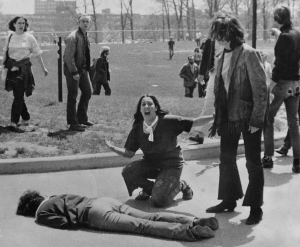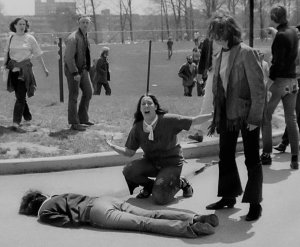
Altered Kent State Photo

Original Kent State Photo
(Second in a series of six articles on photo manipulation)
When looking at beautiful photographic prints created today, the question of manipulation often comes up. Many consumers have a preconceived notion that manipulating a photo is unacceptable and have the mistaken belief that the best photographers do not manipulate their photos. That hard and fast rule of never manipulating a photo applies only to documentary photography. The reputation of magazines, newspapers and the photojournalist can be forever tarnished when they manipulate their photos. An example of this was the 1970 Pulitzer Prize winning photo by John Filo which shows a student, Mary Ann Vecchio, kneeling over the body of a fellow student Jeffrey Miller shot in the Kent State University riot. Study the photos, can you see what was altered or manipulated?
The photo on the right shows an unfortunate pole piercing the head of Ms. Vecchio. Source: http://www.cs.dartmouth.edu/farid/research/digitaltampering/index2.html
Photo Tampering Throughout History
Once that is pointed out, it is had to concentrate on anything else in the photo. It would seem we would all agree that a photojournalist working for a news source should never manipulate their photographs. However, landscape photographers like myself are not photojournalists. In some of the blogs to follow, I hope you will learn more about RAW camera files used by serious digital photographers today and see that even the most well-known photographer, Ansel Adams, ‘manipulated’ his photographs. More correctly, he made artistic decisions about photographs he produced to match the vision he had for the scene he captured. He was not only a master at properly exposing a print, but he was a master in the photo darkroom as well.
Photo Permissions: This image is subject to copyright. Its use here is covered by fair use because: 1) It is a historically significant Pulitzer Prize winning photo. This photo is described in the main stream news media such as an “iconic image” by NPR and by CNN as “a famous photograph.” 2) It appears here in much lower resolution and any copies of it will be of a materially lesser quality then the original. 3) The photo is being used here for educational and informational purposes only. 4) The inclusion of the photo here adds significantly to the article here and s the subject of this discussion.

Original Kent State Photo
